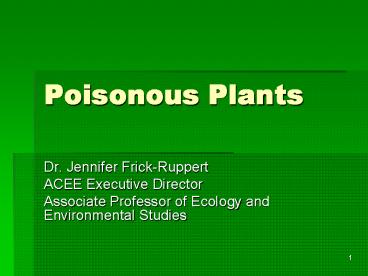Poisonous Plants - PowerPoint PPT Presentation
1 / 17
Title:
Poisonous Plants
Description:
Poisonous Plants Dr. Jennifer Frick-Ruppert ACEE Executive Director ... Some Types of Plant Poisons Alkaloids Derived from amino acids; basic (alkali) ... – PowerPoint PPT presentation
Number of Views:533
Avg rating:3.0/5.0
Title: Poisonous Plants
1
Poisonous Plants
- Dr. Jennifer Frick-Ruppert
- ACEE Executive Director
- Associate Professor of Ecology and Environmental
Studies
2
Poisonous and Medicinal
- Just a matter of degree!
- Nicotine is a great example
- Cigarettes are smoked because the nicotine is a
stimulant it is also addictive - Nicotine is extremely toxic on par with cyanide,
heroin, atropine. - LD50 is less than 5 mg per kg of body weight.
Average lethal dose is 7 drops of pure nicotine. - Nicotine content of cigarettes is regulated to a
maximum of 1 mg per cigarette. - Average human is 155 lbs or 70 kg therefore the
LD50 for a 70 kg human is about 350 mg or 350
cigarettes.
3
Some Types of Plant Poisons
- Alkaloids
- Derived from amino acids basic (alkali)
- Most affect the nervous system because they mimic
or block the action of nerve transmitters - Glycosides
- Sugar-based with attached subgroup it is the
subgroup that determines toxicity - Cyanogenic glycosides release cyanide
Glucosinolates occur in mustard family Cardiac
glycosides act on heart - Oxalic acid
- Crystalline structure is irritating like glass
shards - Rhubarb (Rheum rhabarbarum), Beets (Beta
vulgaris), Sorrels (Oxalis spp., Rumex spp.),
Purslane (Portulaca oleracea) also Arum family - Phenols
- Acidic compounds
- Toxicodendron/Rhus species Poison Ivy, Oak, and
Sumac
4
Edible plants and toxins
- Potato!
- Solanum tuberosum Nightshade Family
- Solanine, a bitter alkaloid
- Present in green parts of leaves, sprouts and
tubers ancestral forms even dark tubers - Dont eat green potatoes!
- Taro, Elephants Ears
- Colocasia esculenta Arum Family
- Staple food of the Pacific Islands
- Contain oxalic acid crystals
- Prepared by washing and pounding to make poi
5
Passage through Food Chain
- Milk sickness
- Cattle eat White Snakeroot (Eupatorium rugosum)
- Milk from these cows sicken people
- Common disease in eastern states Lincolns
mother, my neighbors! - Several compounds including glycosides and a
complex alcohol (tremetol) - Turtles and poisonous mushrooms
- Turtles unaffected humans that eat the turtles
can be sickened
6
Fungal Pathogens on Food
- Ergot poisoning
- Fungus (Claviceps spp.) growing on Rye or Wheat
or other grasses humans eat the flour - Ascomycete fungus makes a hard black elongated
structure - Grain containing more than 0.3 ergot is
prohibited from sale - Over 40 alkaloids present related to lysergic
acid - Symptoms include irritable digestive tract, loss
of balance, convulsions, drowsiness - Witch-hunts of Salem and other towns
- Aflatoxins/Mycotoxins
- Contaminants of grain or other foods
- Penicillium, Aspergillus, Monascus commonly
- Confusion between plant toxicity and mold toxicity
7
Foxglove
- Digitalis purpurea Figwort Family
- Native to England and Europe naturalized in USA
planted in gardens - Contains a cardiac glycoside
- Used to treat dropsy massive fluid retention
caused by poor heart function - Now used in controlled dosages to correct heart
beat irregularities, improve circulation, relieve
fluid buildup, help kidney function
8
Mayapple
- Podophyllum peltatum Barberry Family
- Natives used as emetic and worm expellent also
for syphilis - Strongly irritating to skin and poisonous
- Contains lignans with anti-cancer and anti-viral
properties - Used today to treat venereal warts and testicular
cancer
9
Buckeye
- Aesculus spp. Horse Chestnut Family
- Main toxin is a saponin glycoside (aesculin)
- All parts of plant toxic
- Natives used ground leaves to kill fish
10
Cherries, Peaches, Plums,
- Prunus spp. Rose Family
- Leaves, bark, and seeds (but not fruits) are
toxic - Contain a cyanogenic glycoside (amygdalin)
resulting in cyanide poisoning if ingested - Almonds are the seeds of a species of Prunus that
produces low levels of toxin
11
Poison Ivy, Oak, Sumac
- Toxicodendron or Rhus spp. Cashew Family
- Variable growth form climbing or bushy
- Leaflets in 3 on compound leaves alternate
leaves - Contains an oleoresin (urushiol) in sap pollen
or smoke also irritating - Poison Sumac has alternate, pinnately compound
leaves - Dont confuse with Virginia Creeper
- 5-parted leaves
12
Dolls-Eyes or Baneberry
- Actaea pachypoda and A. rubra Buttercup Family
- All parts toxic, especially berries and roots
- Undetermined toxin, probably a glycoside
- Used by natives as emetic
13
Bloodroot
- Sanguinaria canadensis Poppy Family
- Contains several alkaloids including
sanguinarine very toxic - Used to induce glaucoma in laboratory animals
14
False Hellebore
- Veratrum parviflorum and others Lily Family
- Contain several alkaloids including veratridine
- Can be mistaken for other plants, including
edible Ramps - Used to treat high blood pressure
15
Poison Hemlock
- Conium maculatum and Cicuta spp. Umbel Family
- NOT the Hemlock tree (Tsuga canadensis)
- Resembles wild carrot, but has smooth leaves
- Used to poison Socrates
- European weed, now naturalized USA
- Contains toxic alkaloids related to nicotine
16
Pokeweed
- Phytolacca americana Pokeweed Family
- Several toxic compounds, mostly saponins, but
recently a mitogen that damages blood cells - Young stalks commonly eaten after boiling in
several waters - No longer recommended
17
References
- NJ Turner and AF Szczawinski. 1991. Common
Poisonous Plants and Mushrooms of North America.
Timber Press, Oregon. - S Foster and JA Duke. 1990. Peterson Field Guides
Eastern/Central Medicinal Plants.Houghton Mifflin
Company, Boston. - A Krochmal and C Krochmal. 1984. A Field Guide to
Medicinal Plants. Random House, NY. - Most of the photos in this presentation were from
these references or from various internet sites.
Do not distribute them.












![[PDF] Horse Owner's Guide to Toxic Plants: Identifications, Symptoms, and Treatments Paperback – June 23, 2020 Android PowerPoint PPT Presentation](https://s3.amazonaws.com/images.powershow.com/10078347.th0.jpg?_=202407130610)


















